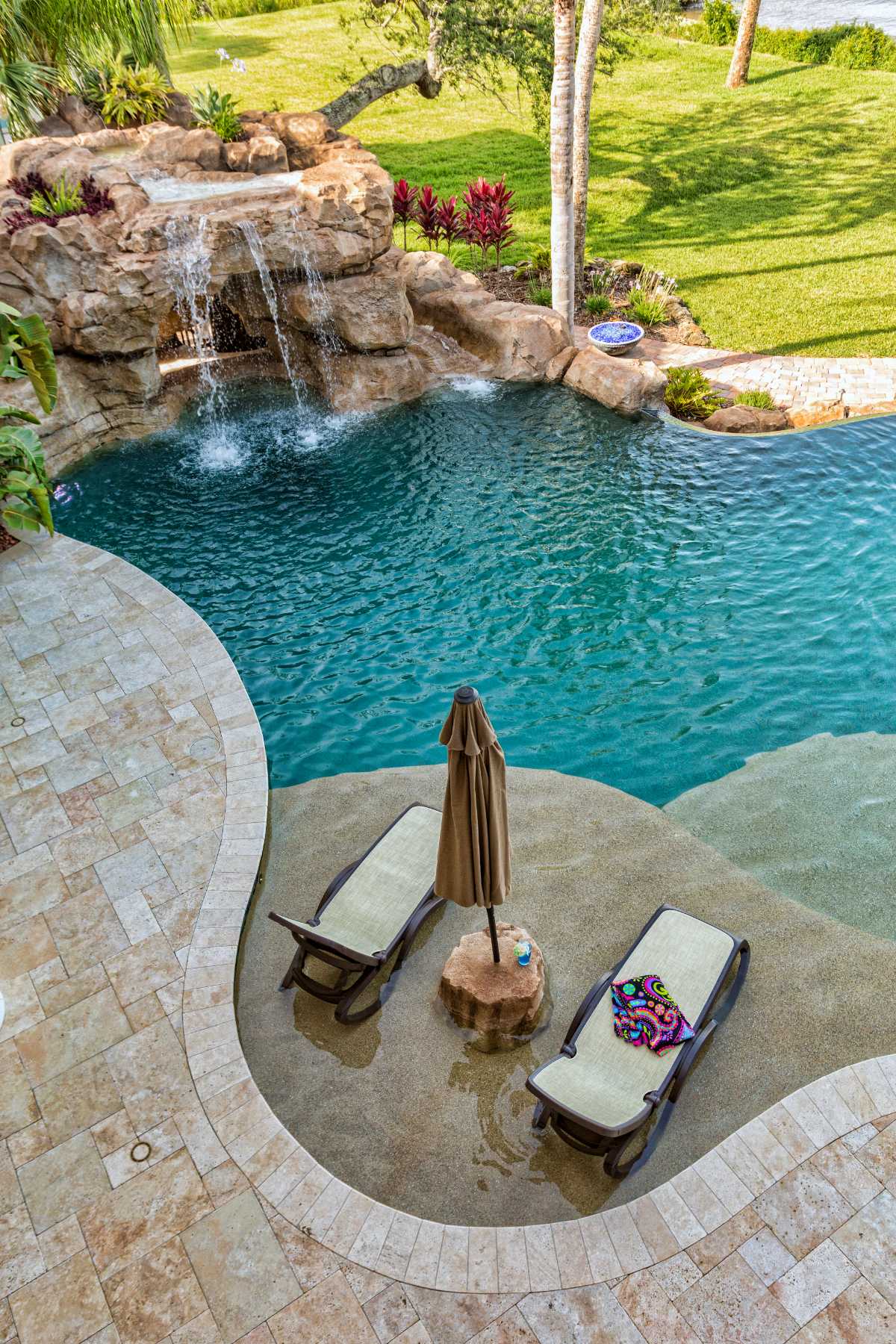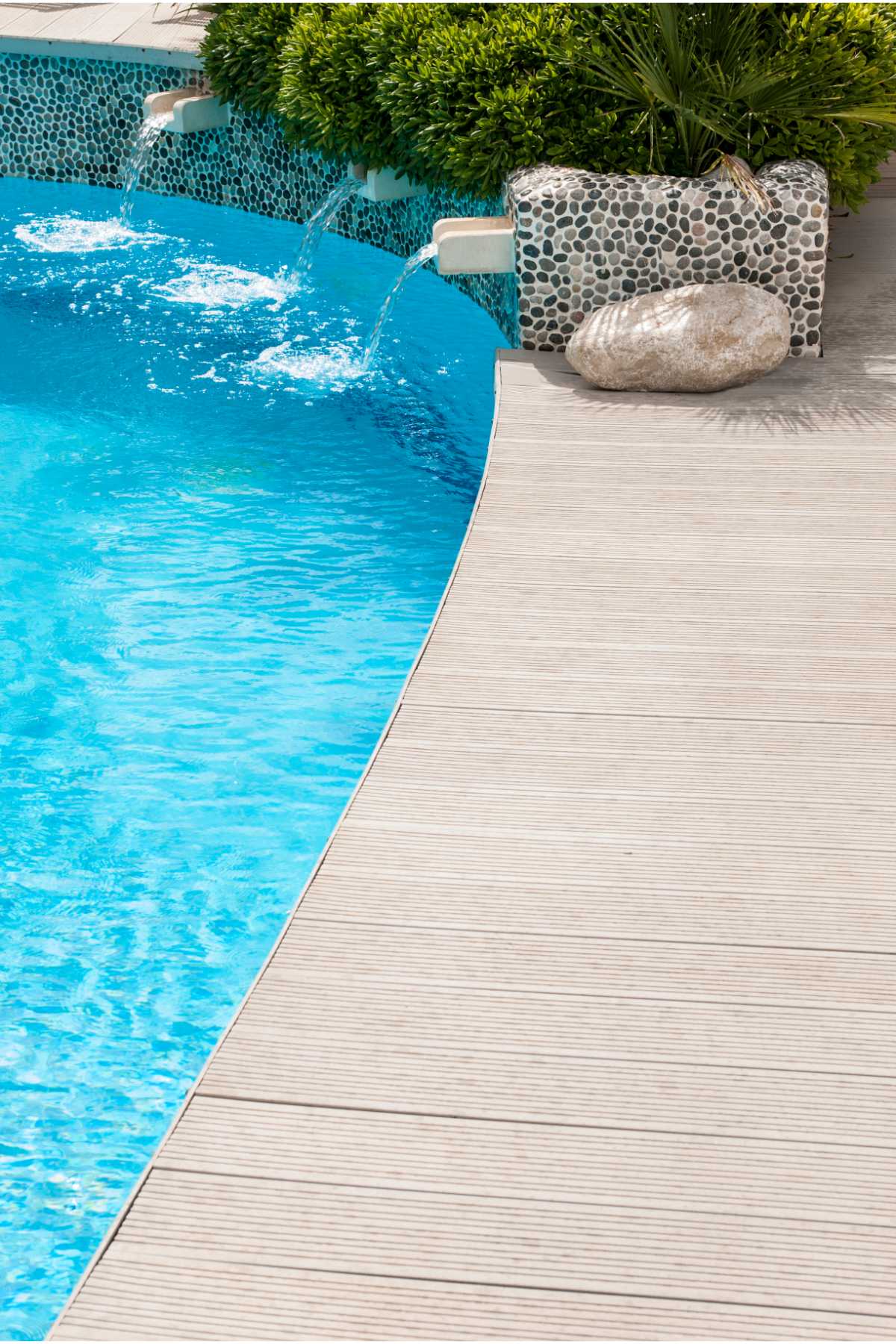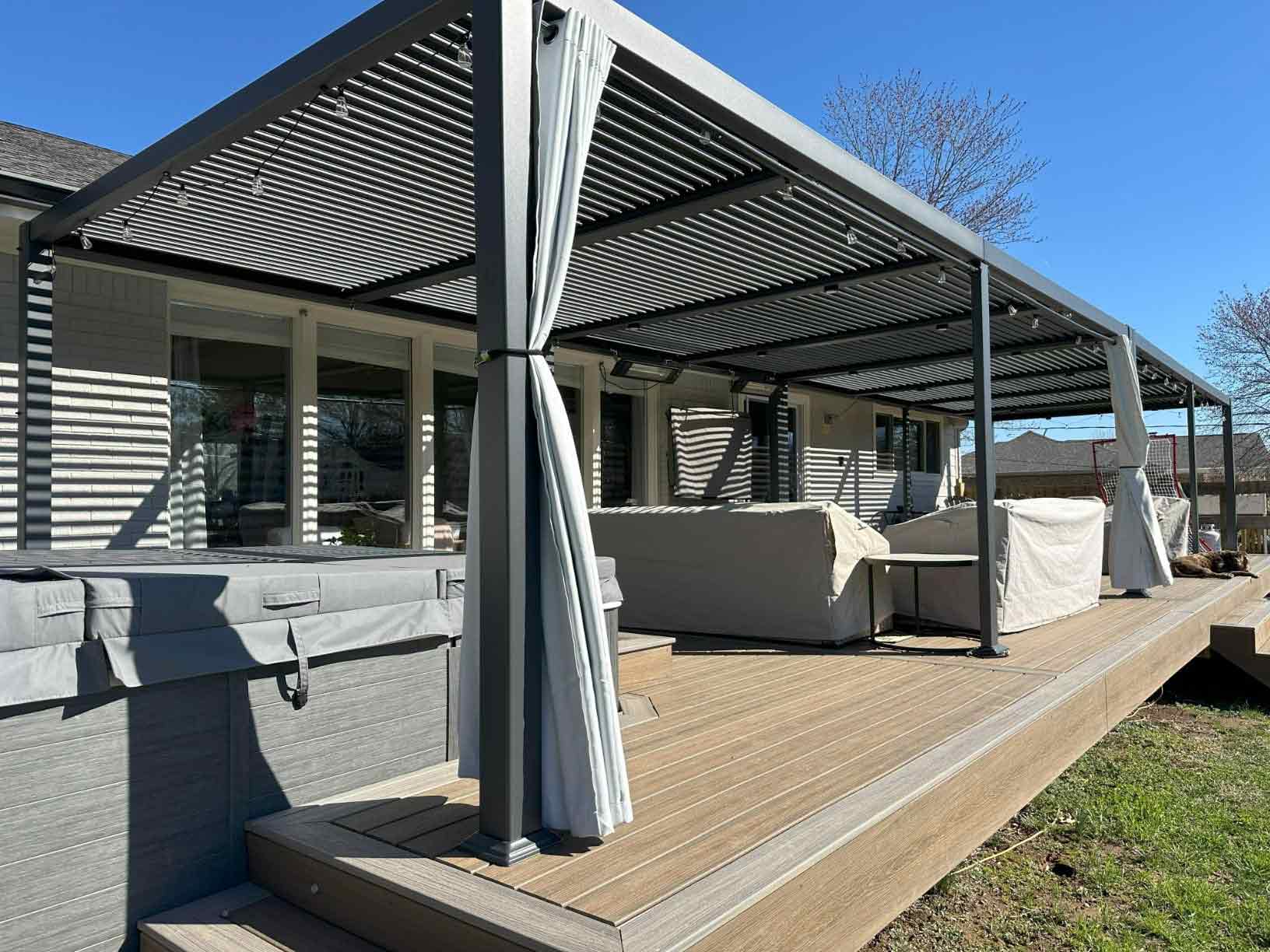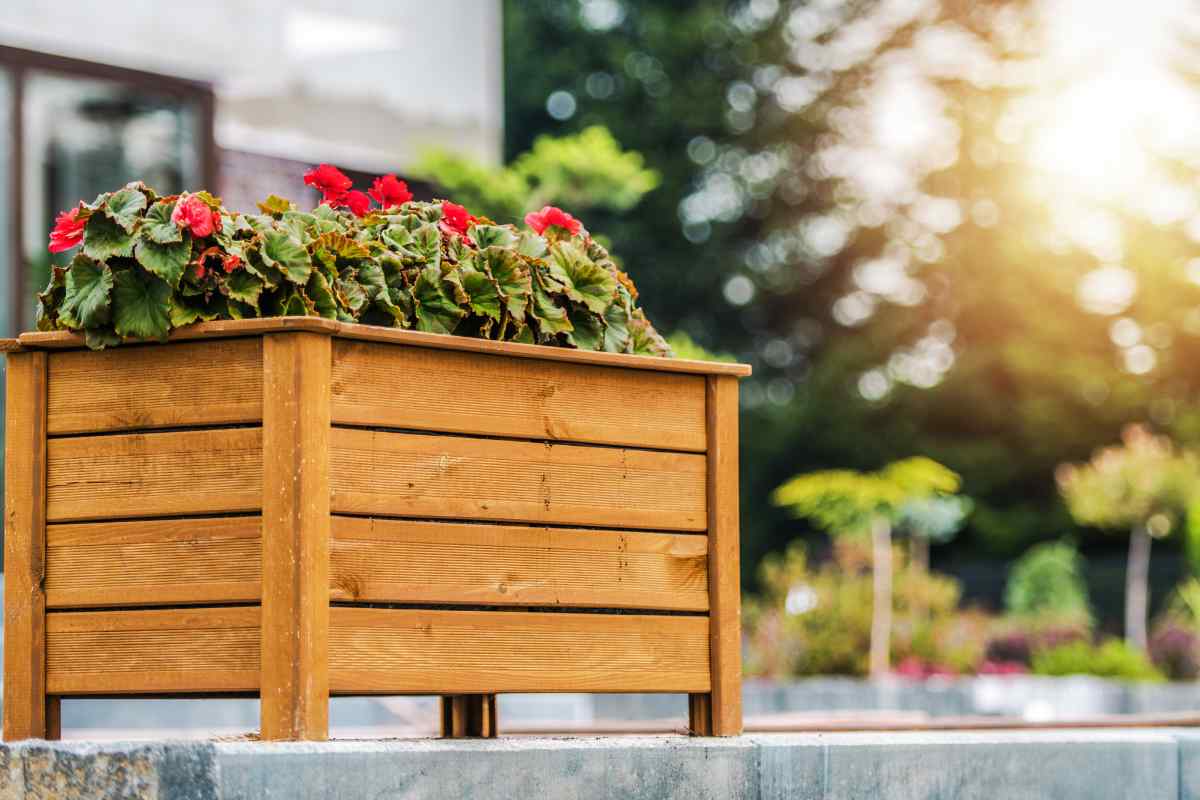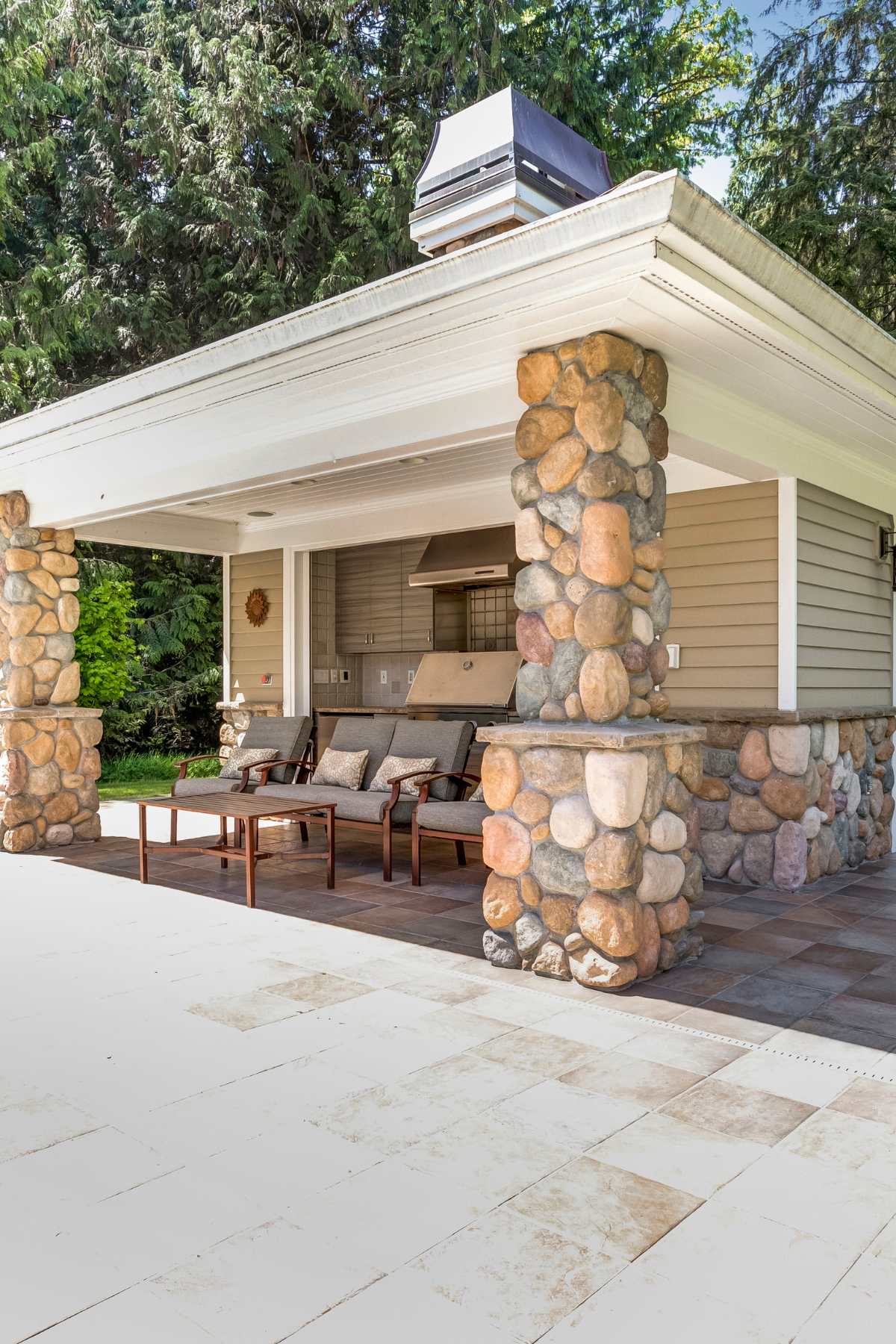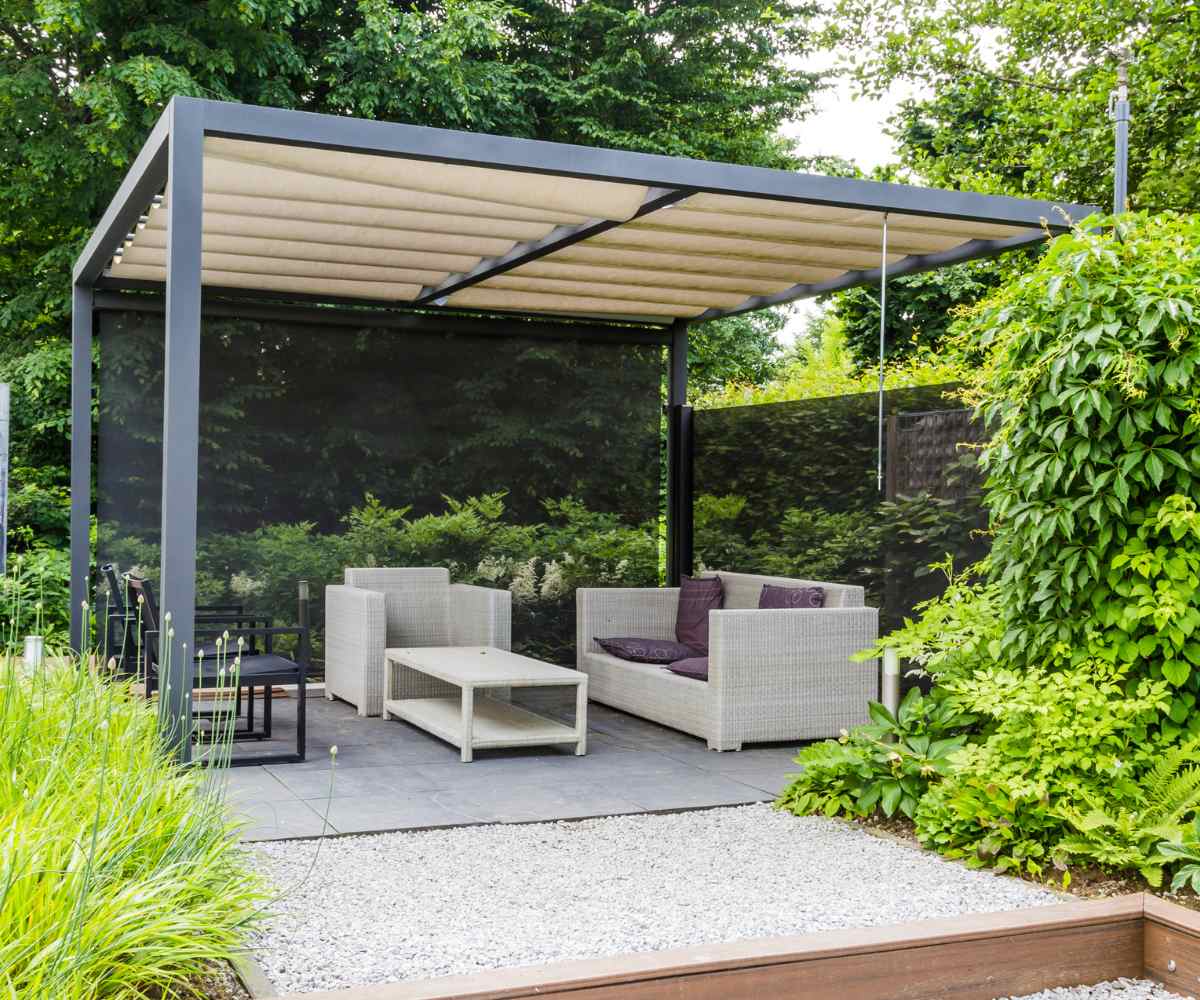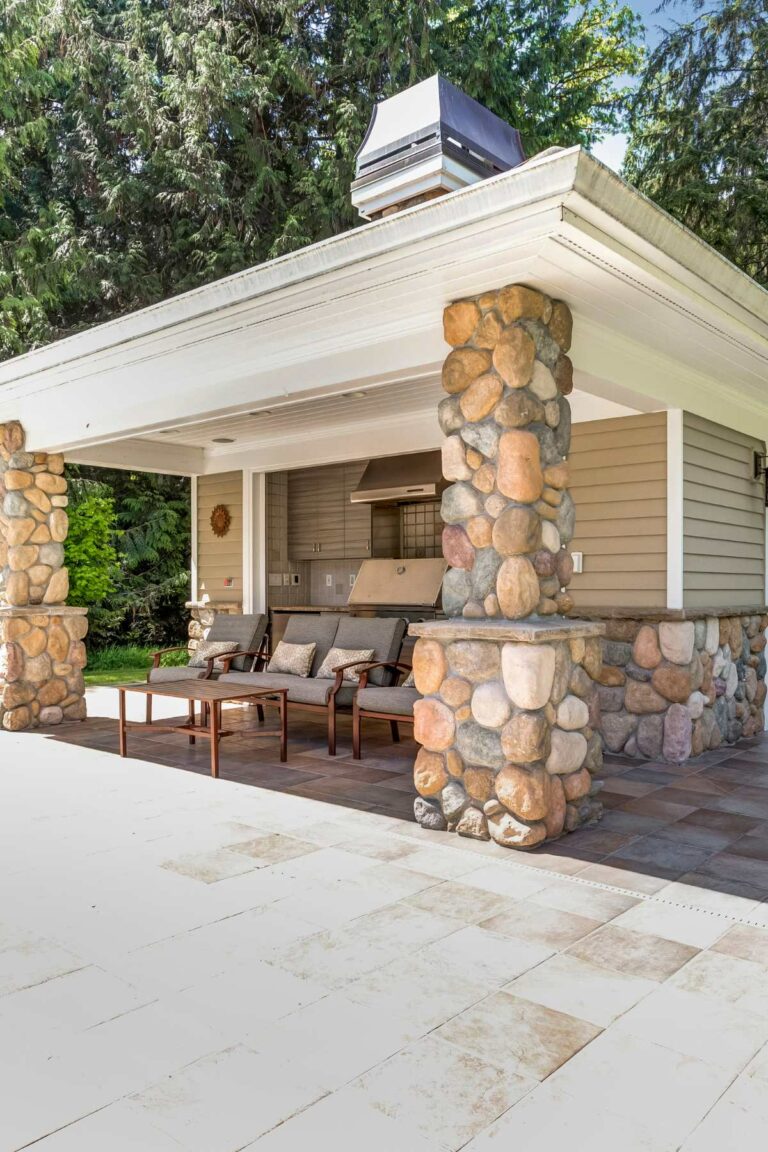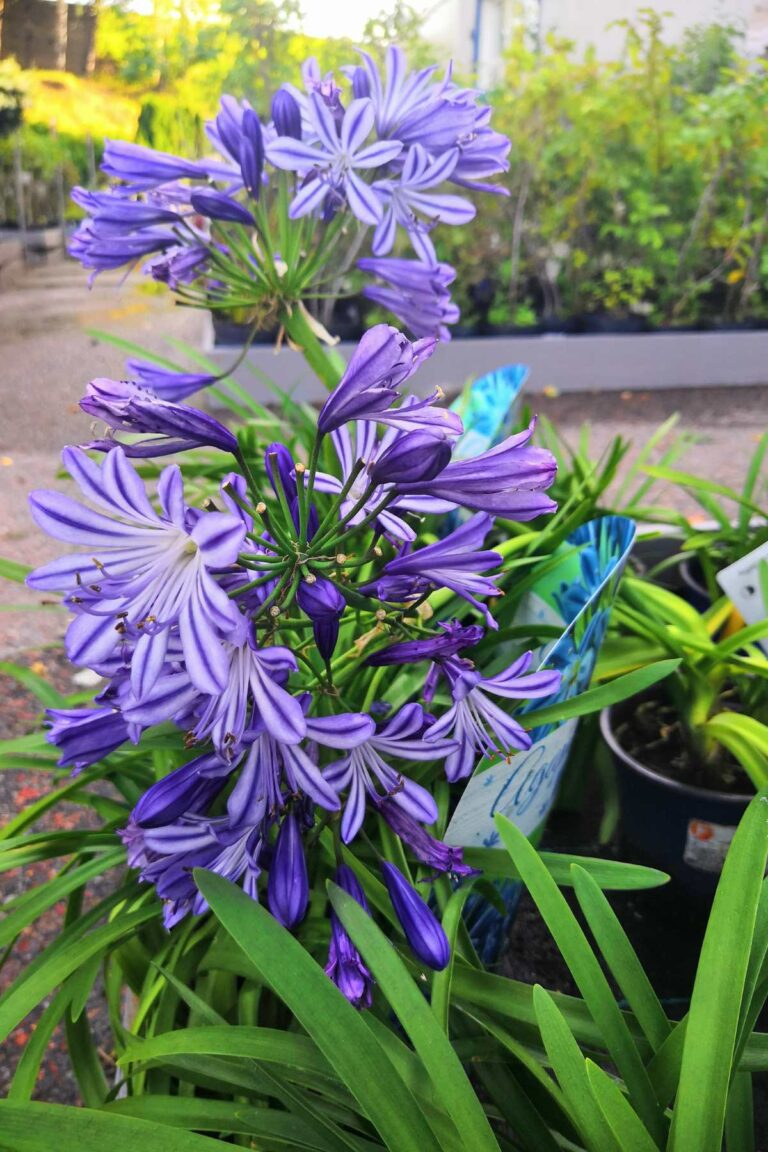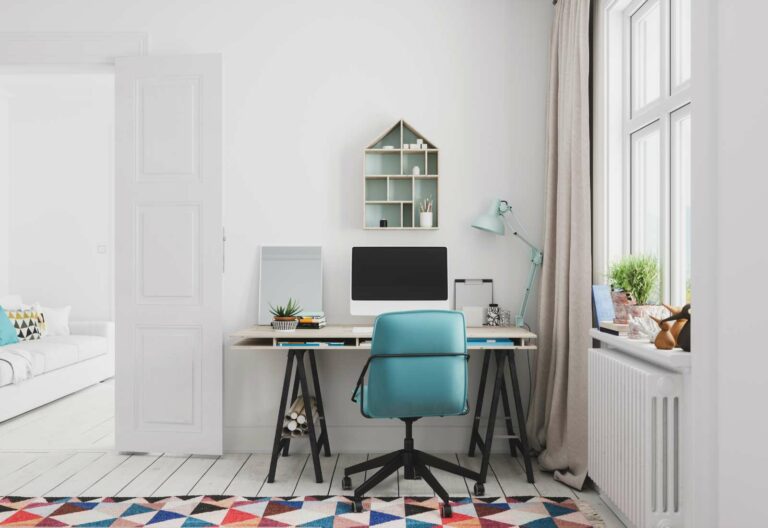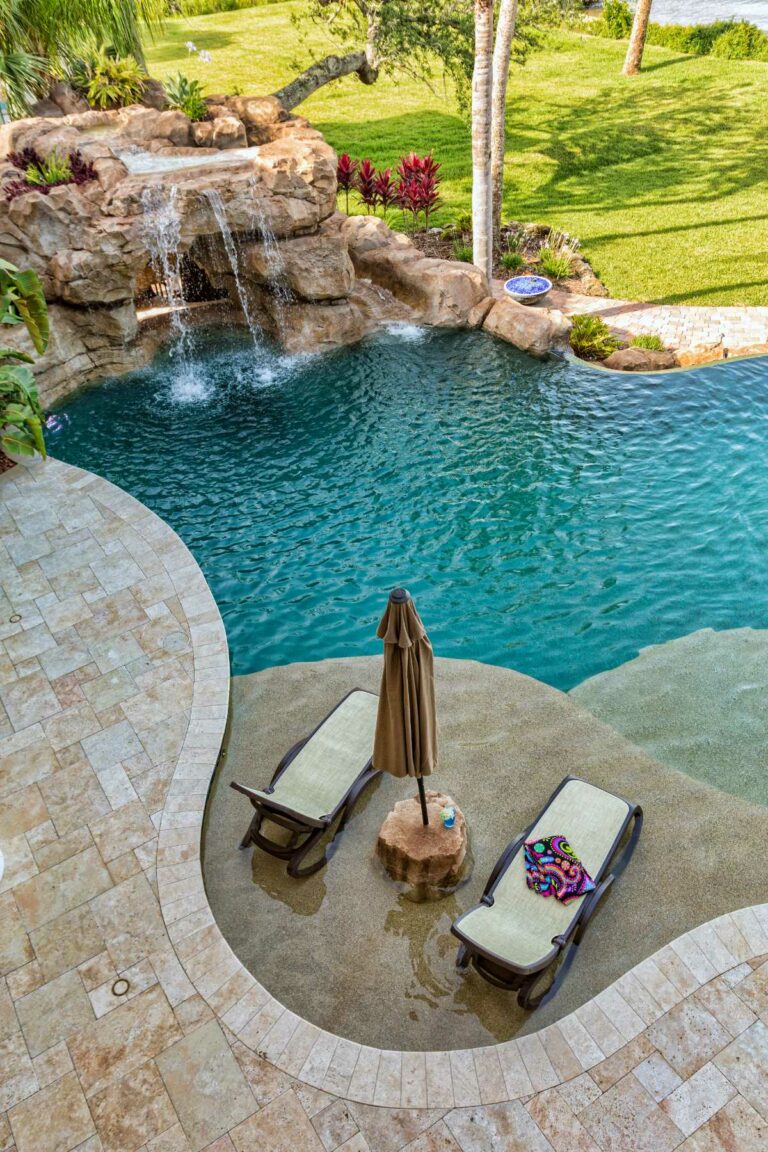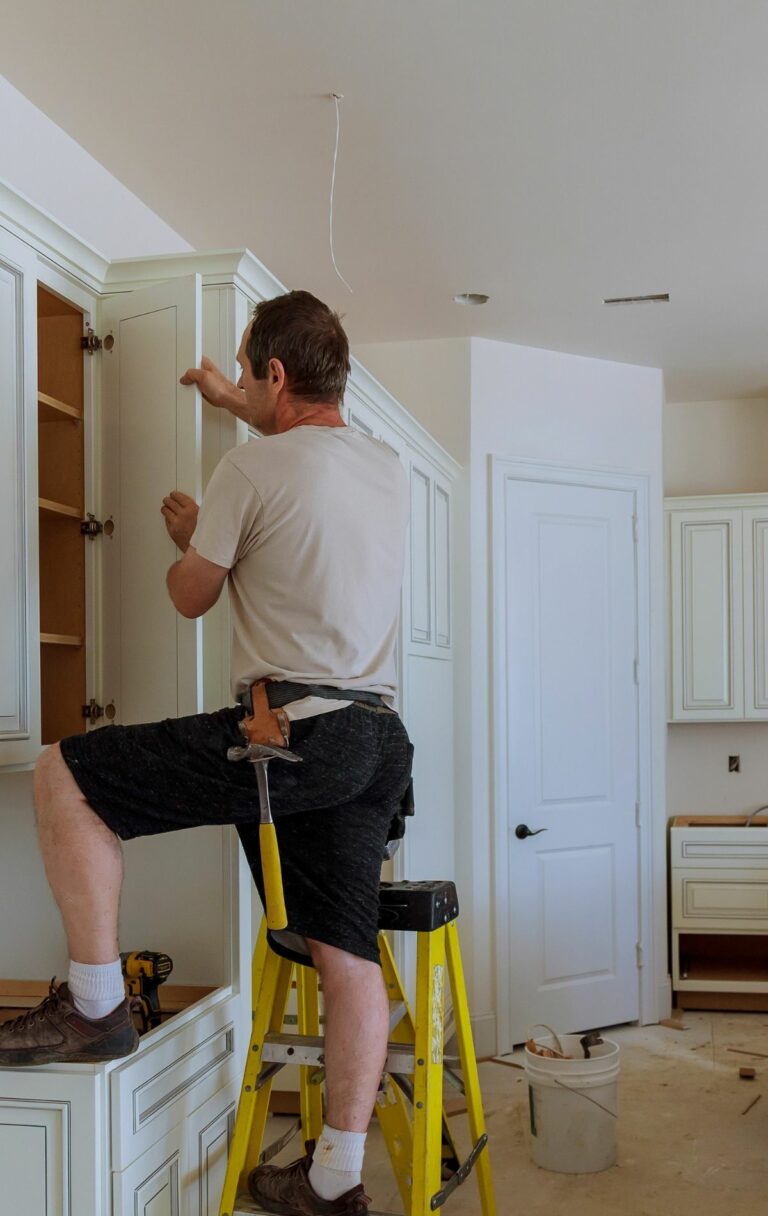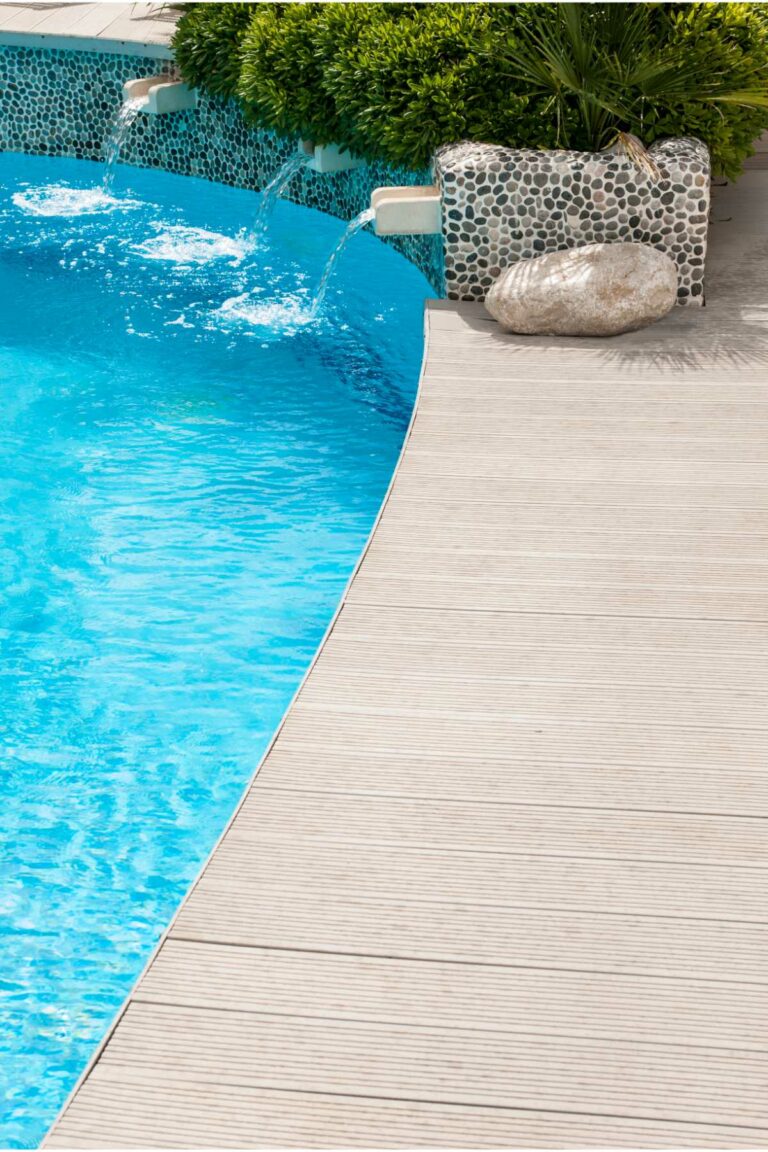How To Clean Pollen Off Your Deck And Porch: Ways, Tips And Cleaners
Struggling with a pollen-coated deck or porch and looking for information on how to clean pollen off? Here you’ll find the best methods and cleaners to remove that sticky mess and keep your outdoor spaces looking neat and clean. This comprehensive guide covers all the necessary tools, safety precautions and how to prepare your deck for cleaning. It also includes tips for choosing the right cleaning solution, different cleaning methods for different deck materials, and advice for rinsing and drying the deck or porch.
You will also find tips for preventing future pollen buildup, dealing with stubborn pollen stains, and maintaining a clean and well-maintained deck.

Ah, spring! A time when nature bursts into color, and… well, our decks and porches get swamped in pollen. I know the struggle all too well – you step outside to enjoy the sunshine, only to find your lovely deck or porch covered in a fine, sticky layer of pollen.
Fret not, my friend, because I’m here to share some practical, tried-and-tested ways to clean that pollen off your outdoor wood deck, patio furniture, or those tricky screened porches, we’ve got you covered!
Pollen Impact on Outdoor Spaces
When it comes to wood and screens, pollen not only looks unsightly but can also lead to staining and a slippery surface – a real slip-and-slide situation, which nobody wants.
Cleaning pollen off your deck is particularly important for people with allergies. When pollen accumulates on your deck, it can be easily stirred up and spread by the wind, potentially exacerbating allergy symptoms for you.
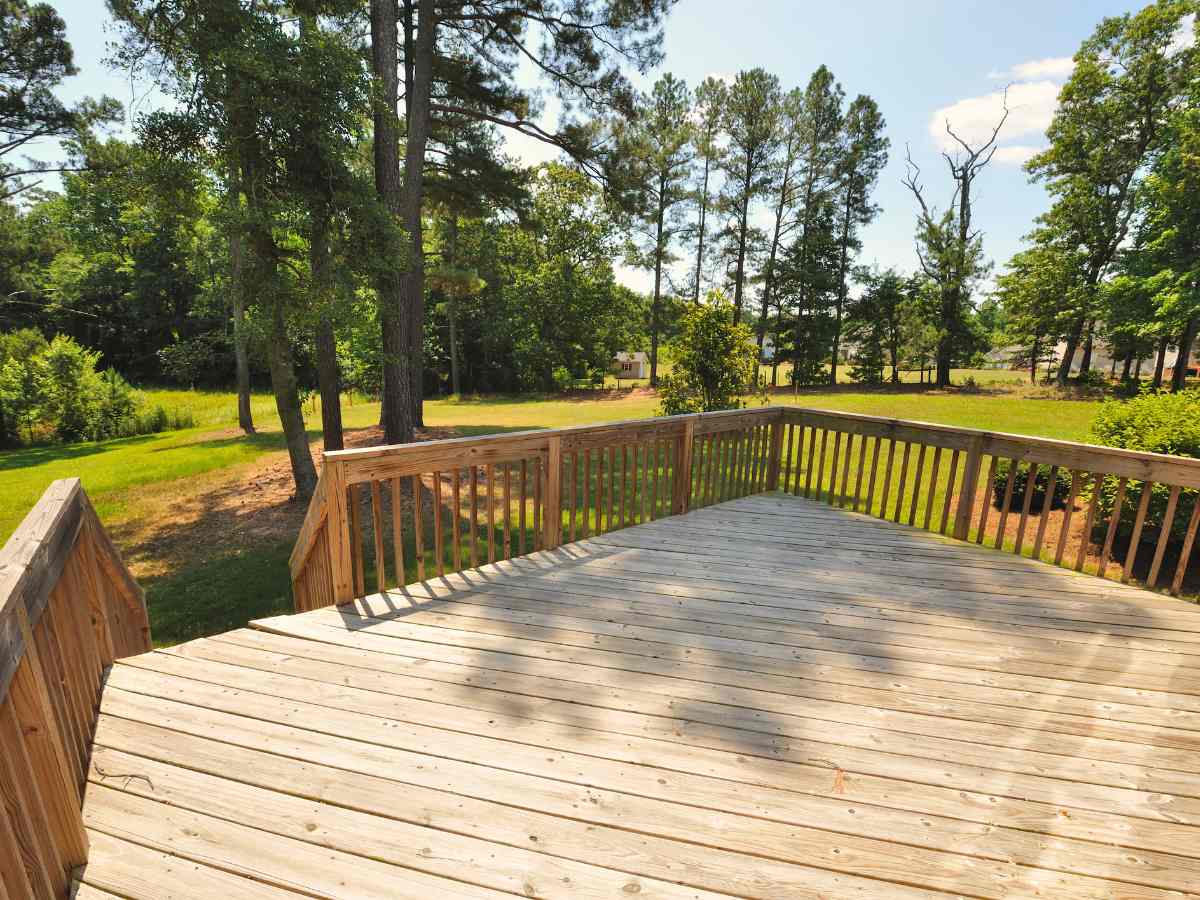
Related: 5 Deck Ideas on a Budget
Tools Needed For Cleaning Pollen Off You Deck
Before we roll up our sleeves, make sure you’ve got the right tools. Cleaning pollen off your deck and porch doesn’t require fancy equipment, but having the right tools and materials at hand can make the job a whole lot easier and more effective. Here’s a more comprehensive list of what you might need:
Heads up: some links are affiliated & I may receive a small commission from qualifying sales. For more info see my disclaimer policy.
List of Tools and Materials Needed
- Soft-bristled brush (this is great for gently sweeping away loose pollen from decks, furniture, and screens. Opt for a brush with soft bristles to avoid scratching surfaces).
- Garden hose with spray nozzle (a hose with an adjustable nozzle can help rinse off surfaces after cleaning. The spray setting is particularly useful as it offers a gentle yet thorough rinse.)
- Deck cleaning solution (opt for an eco-friendly cleaner for safe and effective cleaning);
- Bucket (handy for mixing cleaning solutions and for those areas where a hose might not reach).
- Safety goggles (to protect your eyes from cleaning solutions, pollen, and debris, especially when using a pressure washer);
- Gloves and protective clothing (always a good idea to protect your hands and clothes);
- Pressure washer (ideal for efficiently cleaning larger areas like decks. It can blast away pollen and grime in no time. Just be sure to use it on a setting that’s safe for your surfaces to avoid);
- Sturdy ladder (if necessary).
Optional:
- Leaf Blower (optional) – Quick and easy for blowing away loose pollen, especially in dry conditions. But keep in mind that blowing it off against the wind current will just spread it more.
- Garden Sprayer (optional) – Useful for evenly applying cleaning solutions over large areas.
Related: How To Clean Air Ducts Yourself For Improved Indoor Air Quality
Safety Precautions to Take Before Cleaning
- Wear protective clothing, including long pants, long sleeves, and closed-toe shoes.
- Wear safety goggles and gloves to protect your eyes and hands from the cleaning solution.
- Keep children and pets away from the cleaning area to avoid any accidents.
- Check the weather forecast to ensure that there is no chance of rain during or immediately after cleaning.
- Avoid using abrasive cleaning tools, as they can damage the surface of your deck.
- If using a pressure washer, use a low-pressure setting to avoid damaging the deck surface.
- If necessary, use a sturdy ladder to reach high areas of your deck, and ensure that it is placed on a stable surface.
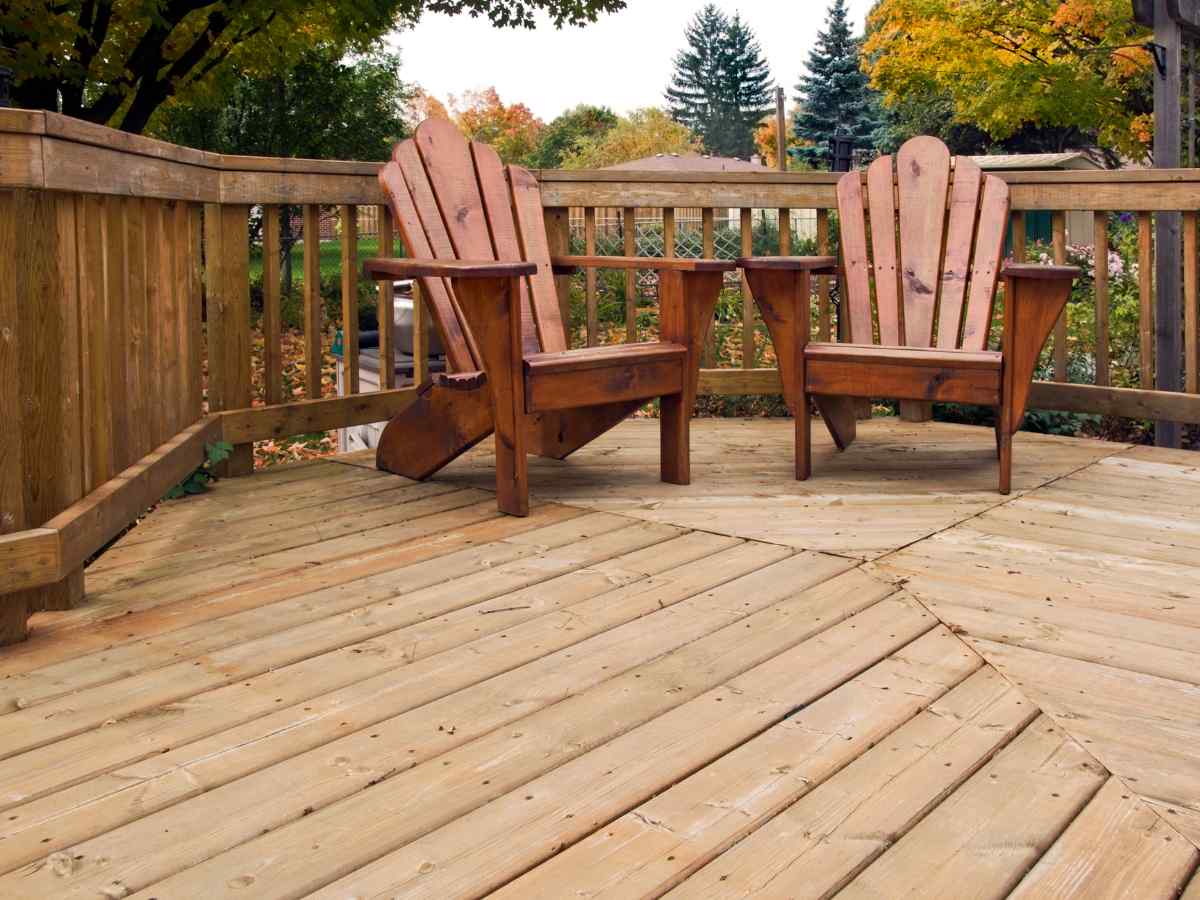
Step-by-Step Guide to Cleaning Pollen Off Wood Surfaces
1. Prepare Your Deck for Cleaning
- Inspect the deck for damages: Before cleaning off the pollen, it is important to inspect the deck for any damages. This includes checking for cracks, splinters, or any other signs of wear and tear. Repair any damages before cleaning to ensure the safety and longevity of your deck.
- Remove furniture and accessories: Clear your deck of any furniture, potted plants, or other accessories to ensure that they do not get damaged during the cleaning process. This also allows you to clean your deck thoroughly without any obstructions.
- Choose the Right Cleaning Solution: Select a cleaning solution that is safe for your deck material and effective in removing pollen. There are tons of commercial cleaners out there, but look for ones labeled for pollen or outdoor use. Some are even formulated for specific surfaces, like wood or metal. Each has its pros and cons, so choose based on your surface and preference, more on that check below!
2. Dry Cleaning
Use a soft-bristle brush or a broom to gently sweep off the loose pollen from the surface. This step is important as it removes the bulk of the pollen without wetting it, which can make it stickier. Another option is to vacuum it.
3. Wet Cleaning
Mix a gentle, eco-friendly soap with warm water in a bucket. Dip a microfiber cloth or sponge into the solution, and wring out excess water to avoid saturating the wood. Gently wipe the wood surfaces with the cloth or sponge. If dealing with tougher spots, a soft-bristle brush can be used, but be gentle to avoid scratching the wood. For large surfaces use a deck brush with handle.
4. Rinsing and Drying Your Deck
After cleaning your deck, it is important to rinse and dry it properly to prevent water damage and ensure it looks its best. Here are some tips for rinsing and drying your deck:
- Rinse thoroughly with a hose to remove cleaning solution and debris.
- Check for soap residue and rinse again if necessary.
- Let the deck dry completely before walking on it or replacing furniture. Depending on the weather and humidity, this may take several hours or even a full day. Do not cover the deck until it is completely dry, as this can trap moisture and cause damage.
- Sealing the Wood (Optional): Consider applying a wood sealant after cleaning (and once the wood is dry) to provide an extra layer of protection against future pollen and other elements.

Tips for using a pressure washer to clean your deck
Cleaning your deck with a pressure washer can be an effective way to remove stubborn pollen and grime. Here are some tips for using these tools:

Use the correct pressure
- Adjust the pressure washer to the appropriate setting for your deck material. Using too much pressure can damage the wood or composite material.
- Start from the top: Start at the highest point of your deck and work your way down to avoid pushing water or debris under the boards.
- Keep a consistent distance: Maintain a consistent distance between the pressure washer and the deck surface to prevent uneven cleaning.
- Move the pressure washer in a continuous motion to avoid leaving streaks or marks on the deck surface.
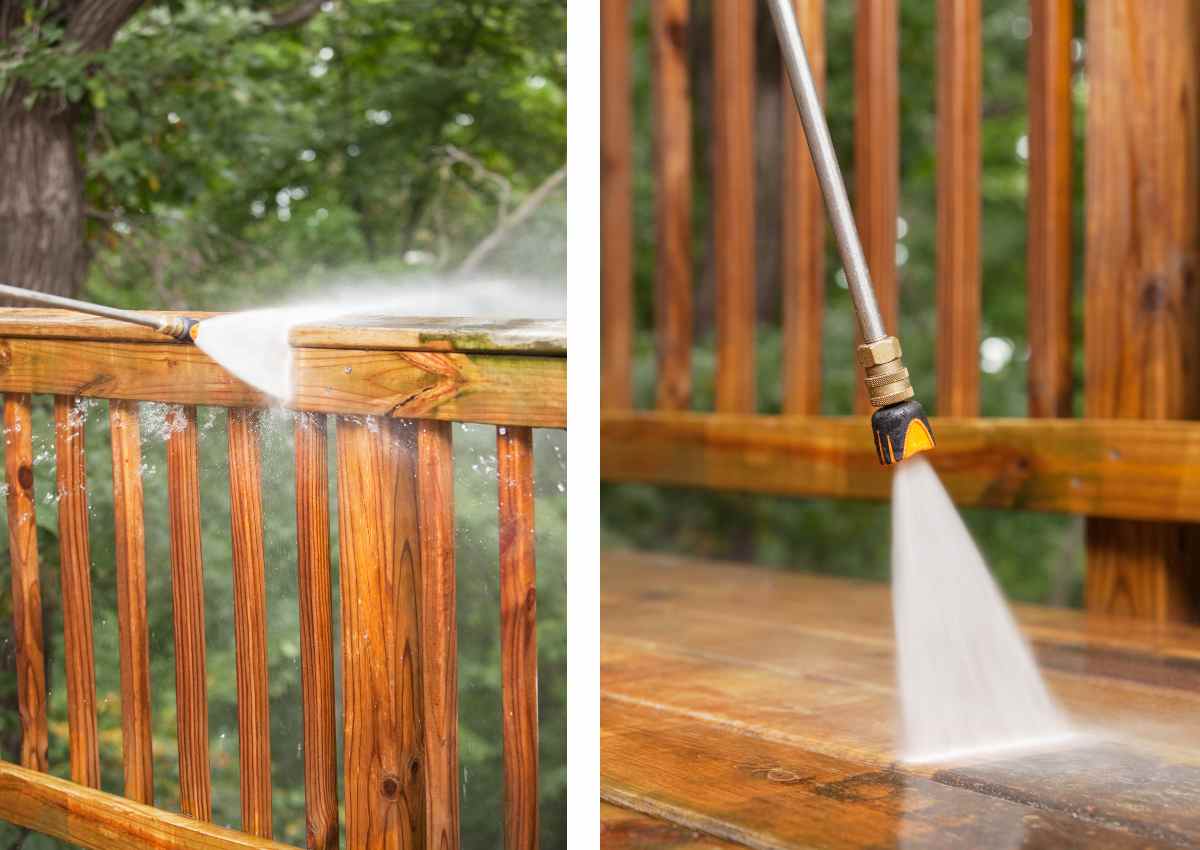
The Best Cleaners for Pollen Removal
When it comes to choosing the right cleaner for removing pollen off you deck, there are several options available:
- All-Purpose Deck Cleaners like this multi-purpose cleaning soap for all outdoor surfaces.
- Pros: These cleaners are formulated specifically for outdoor surfaces, making them effective at removing pollen, dirt, and mildew from decks and outdoor furniture. They often require minimal scrubbing and are easy to use.
- Cons: Some all-purpose deck cleaners can be harsh on certain wood finishes or plants if not used carefully. Always check the label for any specific precautions.
- Eco-Friendly Natural Cleaners
- Pros: Natural cleaners, like those based on citrus or plant extracts, are environmentally friendly and generally safer for use around pets and children. They’re also less likely to harm your landscaping. My favorites are: Charlie’s Soap Non Toxic Outdoor Cleaner or/and Dr. Bronner’s Biodegradable Cleaner.
- Cons: While gentler and safer, they may require more elbow grease and might not be as effective on heavy or set-in pollen stains compared to stronger chemical cleaners.
- Mildew-Specific Cleaners like this 30 SECONDS Mold & Mildew Cleaner.
- Pros: These are great for areas where pollen and moisture mix, leading to mildew. They’re designed to target and eliminate both pollen and mildew effectively.
- Cons: They can be more chemically aggressive, which might not be suitable for all wood types or for those looking for a more natural cleaning solution.
- Pressure Washer Detergents like this Simple Green Oxy Solve Pressure Washer cleaner.
- Pros: If you’re using a pressure washer, these detergents are designed to be used with the machine, offering an effective and efficient cleaning solution. They can cover large areas quickly and rinse off easily.
- Cons: They require a pressure washer, which might not be available to everyone. Also, incorrect use of a pressure washer with these detergents can damage wood surfaces.

Natural DIY Solution Cleaning Pollen Off Your Deck
Ingredients To Prepare The DIY Solution:
- 1 cup of white vinegar
- 1 gallon of warm water
- 1 tablespoon of mild dish soap
- 1/2 cup of baking soda
How To:
In a large bucket, combine the white vinegar and warm water. Stir in the mild dish soap. Slowly add the baking soda to the mixture. It will react with the vinegar, so pour it in gradually to avoid excessive fizzing. Baking soda serves as a gentle abrasive, helping to scrub away stubborn pollen without damaging the surface.
- Pros: Vinegar is a natural, cost-effective option that’s readily available and eco-friendly. It works well on a variety of surfaces and is gentle on the environment.
- Cons: The smell can be off-putting for some, and it might not be as effective on very heavy pollen deposits.
Advice for cleaning different types of deck materials
Different types of deck materials require different cleaning methods to prevent damage and preserve their appearance. Here is some advice for cleaning different types of deck materials:
1. Wood decks
Wood decks require regular cleaning to remove pollen and other debris that can accumulate over time. Use a mild detergent and warm water solution, along with a soft-bristled brush or a pressure washer set to a low pressure setting. Avoid using bleach or other harsh chemicals that can damage the wood fibers. After cleaning, allow the deck to dry completely before applying any stain or sealer.
2. Composite decks
Composite decking is made from a combination of wood fibers and plastic materials. To clean, use a mild detergent like this Timbertech Composite Cleaner (biodegradable), and warm water solution, along with a soft-bristled brush or a pressure washer set to a low pressure setting. Avoid using abrasive scrubbers or wire brushes that can scratch the surface. Rinse thoroughly with a hose and allow the deck to dry completely.
3. PVC decks
PVC decking is made from synthetic materials that are resistant to stains and mildew. To clean, use a mild detergent and warm water solution, along with a soft-bristled brush or a pressure washer set to a low pressure setting. Avoid using abrasive scrubbers or wire brushes that can scratch the surface. Rinse thoroughly with a hose and allow the deck to dry completely.
4. Concrete decks
Concrete decks require regular cleaning to prevent staining and mildew growth. Use a commercial concrete cleaner or a mixture of warm water and vinegar, along with a stiff-bristled brush or a pressure washer set to a high pressure setting. Avoid using bleach or other harsh chemicals that can damage the surface. Rinse thoroughly with a hose and allow the deck to dry completely.
How To deal with stubborn pollen stains on your deck
- Use a cleaning solution or commercial deck cleaner and scrub gently with a soft-bristled brush.
- Try a solution of water and white vinegar for more stubborn stains.
- Use a pressure washer set to a low pressure setting.
- Sand and refinish if the stains are still visible.
Cleaning Pollen Off Patio Furniture
Patio furniture comes in various materials, so approach each with care. For plastics and metals, soapy water works wonders. For more delicate materials, consider a cleaner specifically designed for that surface. Always test a small area first!
How to Tackle Pollen On Porch Screens
Screened porches can be tricky. For the screens, gently vacuuming or using a soft brush can work well. Avoid using too much water, as it can damage the screens. For the porch itself, follow the same steps as for the wood surfaces.
Tips For Preventing Future Pollen Buildup Or A Pollen-Free Deck
Maintaining a clean and pollen-free deck is an ongoing process. Here are a few tips that can help prevent future buildup and keep your deck looking great.
- Sweep regularly: Use a broom or leaf blower to remove debris and pollen from your deck regularly. This will prevent buildup and make cleaning easier in the future.
- Trim nearby trees and plants: If possible, trim nearby trees and plants to reduce the amount of pollen that falls on your deck.
- Use a deck cover: A deck cover can protect your deck from pollen and other debris when it is not in use. Just make sure to remove it and let your deck dry completely after rainfall.
- Apply a sealant: Applying a sealant to your deck can protect it from moisture and prevent pollen and other debris from sticking.
- Consider a pollen-resistant material: If you are planning to build a new deck, consider using a material that is resistant to pollen, such as composite decking.
FAQs
Vacuuming pollen off your porch can be a practical approach, especially if the pollen is dry and loose. It’s particularly effective on surfaces like screened porches where sweeping might be challenging.
For fabric items like cushions, gently vacuum to remove loose pollen. Then, use a mixture of mild soap and water to spot clean. Avoid harsh chemicals that can damage the fabric. For tougher stains, check the manufacturer’s instructions or consider a fabric cleaner designed for outdoor furniture.
Power washing can be effective but also risky if not done correctly. High pressure can damage the wood, stripping away paint or finish, and even splintering the wood. If you use a pressure washer, use it on a low setting and keep a reasonable distance from the surface.
Yes, vinegar can be effective in removing pollen stains. Its acidic nature helps break down and lift the stains. Use the recipe provided above.
Cleaning pollen off your deck is an essential part of maintaining a clean and appealing outdoor living space. By following the steps we have discussed, including preparing your deck, choosing the right cleaning solution, and properly rinsing and drying your deck, you can effectively clean pollen and other debris from your deck. With these tips, you can enjoy a clean and beautiful deck throughout pollen season and beyond.
©HomeAndHues. Content and photographs are copyright protected and need prior permission to use. Copying and/or pasting full text or media to other websites and any social media is strictly prohibited. Sharing and using the link of this post is both encouraged and appreciated!

